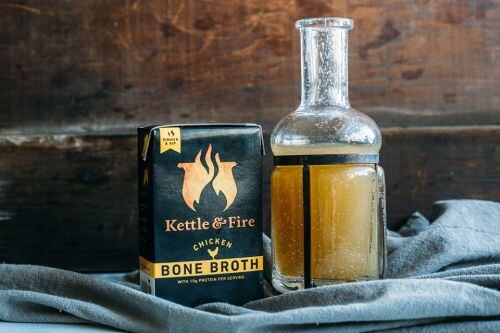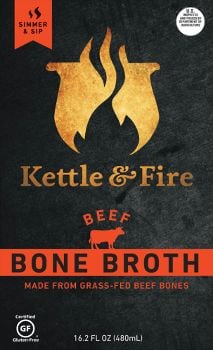While bidding for a slice of a $20m market (which is likely somewhat larger when you include online channels and frozen products) might not inspire many big CPGs to get out of bed in the morning, it’s proved motivating enough for scores of start-ups to enter the market in the past couple of years, observes Justin Mares, co-founder at San Francisco-based bone broth brand Kettle & Fire – and one of the first six companies to go through Chobani’s 2016/17 incubator program.
“We’ve had a very positive response from retailers as they are very aware of the bone broth trend and they want to reinvigorate a pretty dead category,” added Mares, who sells organic, shelf-stable bone broth (there are two SKUs: grass-fed beef, and chicken) in TetraPaks with a two-year shelf-life and no preservatives.
“They see that most of the growth in the [broth] category is coming from bone broth, which is great for them because it’s a higher margin product.”
Channel strategy
Kettle & Fire - which started by Justin and his brother Nick as a direct to consumer operation (selling via its own website and other online channels such as Thrive Market) – is now steadily increasing its bricks & mortar presence, he told FoodNavigator-USA.
“We’re currently available in over 300 stores, mainly on the west coast including Whole Foods, and will be going into a lot more in early summer. We think we’ll be in close to 2,000 stores by the end of the year.”
While beginning online helped validate their assumptions that target consumers were health-conscious foodies on the coasts coupled with some cities such as Austin and Chicago – which has in turn influenced the bricks & mortar strategy – it has also proved to a be a good testing ground for new ideas, he said.
“We’ve invested really heavily in building an online business – mostly through our own website - so we can talk to our customers, ask them what they want to see next, test new things and see who raises their hands and says yes, that’s what we want to buy. And we’ve seen really strong repeat business which validates what we’re doing.
“Right now, we’re targeting people that are already familiar with bone broth and maybe making their own, but want something more convenient. Later on, we may need to change our strategy to appeal to a broader set of consumers, but we'r activating those [Paleo, Whole30, health-conscious] communities first."

Made from meaty bones and veggies that are left to simmer and then strained, bone broth is basically stock, but is typically made with higher-quality ingredients, and simmered for considerably longer (up to 48 hours – whereas commercial stock brands are typically cooked for a couple of hours) such that the final product has more protein, more nutrients and a gelatinous quality once it cools down.
It is also designed to be sipped as a hot beverage, rather than used as a cooking ingredient.
Evangelists insist bone broth is more nutritious than commercial brands of stock because the lengthy cook time breaks down the bones and releases joint-friendly nutrients such as glucosamine, plus proteins found in bone and connective tissue such as collagen and gelatin.
Skeptics, in turn, observe that collagen breaks down into amino acids - which are used by the body as needed - when you ingest it, rather than making a beeline for your joints/bones; while you’d need to consume gallons of bone broth before you took in the amount of glucosamine proven to benefit joints in clinical studies.
That said, no one disputes bone broth is a lot more nourishing than many other beverages on the market, says Kettle & Fire co-founder Justin Mares.

Merchandising bone broth: Frozen, chilled, shelf-stable?
While many start-ups are selling frozen products in pouches online, and some recent entrants (BRU Broth, EPIC) have positioned themselves in the grab & go chillers with other premium products such as cold-pressed juices, the shelf-stable market is the biggest market,** and intuitively where consumers look for bone broth, he said.
“I think the data bears that out. I think convenience and accessibility will win out at the end of the day.”
So what was the Chobani incubator experience like for Kettle & Fire, which recently raised an undisclosed sum in a small seed round from some influencers in the health and wellness arena.
“Tremendous,” said Mares.
“The money aside [the six companies in the first wave each received a $25,000 equity-free, no strings attached, grant] the most useful piece was seeing how a successful food company operates at scale.
“It’s hard to think of another company that’s grown as fast in such a short space of time. We got a lot of help with how we might approach different retailers, and we also got to meet with Hamdi a couple of times; he was very involved.”

'NOT ALL BONES ARE CREATED EQUAL'
So what’s different about Kettle & Fire bone broth? First, it’s organic; second, it’s made with bones from grass fed, pasture raised cattle that are hormone and antibiotic free; third, it’s cooked at a slow simmer for more than 24 hours; and fourth, it uses an apple cider base rather than a tomato base; says the San Francisco-based brand, which launched with a beef bone broth, and has recently unveiled a chicken bone broth.
“We are also very selective when it comes to the types of bones we use," says co-founder Justin Mares. "Not all bones are created equal, which is why we only use knuckle, patella, femur, and feet bones. These bones have been shown to contain the highest concentration of white and red stem-cell marrow, as well as high levels of collagen.”
*SPINS MULO (multi-outlet), Natural channel and Specialty Gourmet channel, 52 weeks ending Jan 22, 2017
**According to SPINS, US retail sales of shelf-stable bone broth rose to $17.54m in the 52 weeks to Jan 22, 2017, up from $5.83m the previous year; while sales of refrigerated bone broth rose to $2.18m, up from $192k the previous year (MULO, Natural, and Specialty Gourmet channel)
